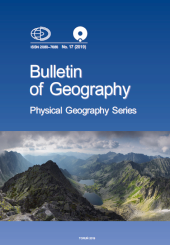Light pollution in the night sky of Toruń in the summer season
DOI:
https://doi.org/10.2478/bgeo-2019-0017Keywords
light pollution, SQM, land use/cover, ToruńAbstract
The paper presents results of research on light pollution in the night sky of Toruń. A permanent network of measuring stations has been established in the city, consisting of 24 sites representing various types of land development and land cover: single-family housing, city centre, multi-family housing, areas overgrown with vegetation and open areas. Within this network, a repeatable direct measurement of the sky brightness using an SQM photometer was carried out over a period of three consecutive months in the summer season, i.e. from June to September 2017. The measurement sessions were conducted in similar weather and astronomical conditions. Based on the obtained data, a spatial distribution of light pollution was determined, ranges of values obtained during the measurements were provided, and the results were additionally referred to the distinguished land cover categories and land development types.References
CINZANO P and FALCHI F, 2016, The new world atlas of artificial night sky brightness, Science Advances.
CONNORS BM, 2010, Effect of artificial light on marine invertebrate and fish abundance in an area of salmon farming. Marine Ecology Progress Series.
DEPLEDGE M, GODARD-CODDING CAJ and BOWEN R, 2010, Light pollution in the sea. Marine Pollution Bulletin, 60(9): 1383–5.
FALCHI F, CINZANO P, ELVIDGE C, KEITH D and HAIM A, 2011, The expanding use of light at night is due to the fact that humans are diurnal animals that are trying to extend activities into the usually dark hours. Journal of Environmental Management, 92: 2714–2722.
HÄNEL A, POSCH T, RIBAS SJ, AUBÉ M, DURISCOE D, JECHOW A, KOLLÁTH Z, LOLKEMA DE, MOORE C, SCHMIDT N, SPOELSTRA H, WUCHTERL G and KYBA CCM 2017, Measuring night sky brightness: methods and challenges. Journal of Quantitative Spectroscopy and Radiative Transfer.
JECHOW A. RIBAS SJ, CANAL-DOMINGO R, HÖLKER F, KOLLÁTH Z and KYBA CCM, 2019, Tracking the dynamics of skyglow with differential photometry using a digital camera with fisheye lens. Journal of Quantitative Spectroscopy and Radiative Transfer, 209: 212–223.
JONES J and FRANCIS CM, 2003, The effects of light characteristics on avian mortality at lighthouses. Journal of Avian Biology, 34: 328–333.
KOCIFAJ M, 2007, Light pollution model for cloudy and cloudless night skies with ground-based light sources. Applied Optics, 46,(15): 3013–3022.
KOLLÁTH Z, 2010, Measuring and modelling light pollution at the Zselic Starry Sky Park. Journal of Physics Conference Series, 218(1): 012001.
NAVARA KJ and NELSON RJ, 2007, The dark side of light at night: physiological, epidemiological, and ecological consequences. Journal of Pineal Research, 43(3): 215–224.
PARA A and PARA A, 2013, Świadomość skażenia otoczenia człowieka radonem. Przegląd Naukowy – Inżynieria i Kształtowanie Środowiska, 59: 88–97.
PUN CSJ, SO CW, LEUNG WY and WONG CF, 2013, Contributions of artificial lighting sources on light pollution in Hong Kong measured through a night sky brightness monitoring network. Journal of Quantitative Spectroscopy and Radiative Transfer, 2014;139:90–108. doi: http://doi.org/10.1016/j.jqsrt.2013.12.014
QADRI R and FAIQ MA, 2019, Freshwater Pollution: Effects on Aquatic Life and Human Health. Fresh Water Pollution Dynamics and Remediation. Springer Press, Singapore.
ROGE-WIŚNIEWSKA M, 2015, Światło – Dobrodziejstwo czy problem?, [In:] Przejdź na ciemną stronę nocy. Środowiskowe i społeczne skutki zanieczyszczenia światłem, red. Roge-Wiśniewska M, Tomasik K, Wyd. Uniwersytetu Warszawskiego, Warszawa.
ŚCIĘŻOR T, KUBALA M, KASZOWSKI W and DWORAK TZ, 2010, Zanieczyszczenie świetlne nocnego nieba w obszarze aglomeracji krakowskiej. Analiza pomiarów sztucznej poświaty niebieskiej, Wyd. Politechniki Krakowskiej, Kraków.
ŚCIĘŻOR T, 2018, Naturalne i antropogeniczne czynniki łuny świetlnej nocnego nieba. Monografie Politechniki Krakowskiej, Kraków.
SKWARŁO-SOŃTA K, 2014, Melatonina: hormon snu czy hormon ciemności? Kosmos, problemy Nauk Biologicznych, 63(2): 223–231.
STEVENS RG, 2009, Light-at-night, circadian disruption and breast cancer: assessment of existing evidence. International Journal of Epidemiology, 1–8.
WANG LK, PEREIRA NC and HUNG YT, 2004, Air Pollution Control Engineering. Humana Press Inc.
WANI KA, MANZOOR J, DAR AA, SHUAB R and LONE R, 2019, Heavy Metal Intrusion and Accumulation in Aquatic Ecosystems. Fresh Water Pollution Dynamics and Remediation. Springer Press, Singapore.
WOJCIECHOWSKA A, WIŚNIEWSKA A and BARCIKOWSKI A, 2014, Zanieczyszczenie światłem – ekologiczny problem współczesnego miasta. Prace i Studia Geograficzne, 53: 109–128.
WOŹNY A, DOBOSZ M and PACANA A, 2014, Wpływ hałasu na jakość pracy. Humanities and Social Sciences, HSS, vol. XIX, 21(2): 251–258.
WYSZKOWSKI M and WYSZKOWSKA J, 2007, Zanieczyszczenie gleby kadmem a zawartość makropierwiastków w roślinach. Ochrona Środowiska i Zasobów Naturalnych, 31, Warszawa.
ZIMOCH J, 2017, Sztuczne światło przeszkadza nocnym owadom w zapylaniu kwiatów, http://wyborcza.pl/7,75400,22233046,sztuczne-swiatlo-przeszkadza-nocnym-owadom-w-zapylaniu-kwiatow.html (02.06.2018).
ŻUREK ZH, JASIŃSKI T, GLINKA T and SOBOTA J, 2017, Pole magnetyczne wokół transformatorów energetycznych. Przegląd Elektrotechniczny, 1(11): 54–56.
Downloads
Published
How to Cite
Issue
Section
License
Copyright (c) 2020 Bulletin of Geography. Physical Geography Series

This work is licensed under a Creative Commons Attribution-NoDerivatives 4.0 International License.
Stats
Number of views and downloads: 559
Number of citations: 9



